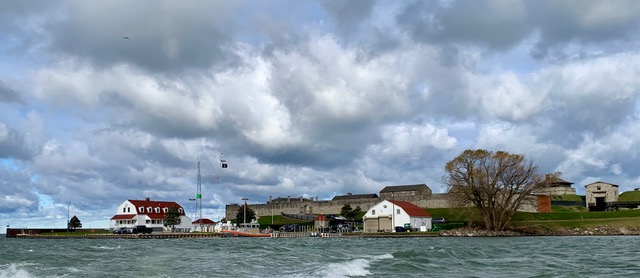Now, that’s one big fish,” I said, lifting my first lake trout—a 30-inch, 15-pound beast—out of the oversized net just raised from the powerful waters of the lower Niagara River off shore of Lewiston, New York.
My fishing guide that day, Capt. Frank Campbell, responded with a chuckle and a grin: “Oh, that laker, it’s just about average for this river…we recently caught a 40-incher.”
I can’t even imagine what a 40-inch, 30-pound laker looks like.
But that’s really no surprise, considering that many anglers—unbeknownst to me before this trip—consider the Greater Niagara region of Western New York to be the best freshwater fishery in the country.
That’s quite a boast, but by the end of my quick two-day mid-November trip, I really couldn’t argue. It wasn’t just hype.
Supporting this claim is the fact that the Greater Niagara region includes Lake Erie and Lake Ontario, the lakes’ tributaries and the Niagara River, which takes the water that cascades over Niagara Falls from Lake Erie and sends it on to Lake Ontario.
Indeed, Capt. Frank told me that the flow in the Niagara river is so powerful that they measure it in miles per hour (mph) rather than cubic feet per second (cfs) like many other rivers.
That’s a whole lot of water—which means only one thing to the angler: Fishing!
The Niagara River and the entire Great Lakes Basin is a legacy of the last Ice Age. Over 18,000 years ago, Southern Ontario was covered by ice sheets several kilometers thick. As the ice sheets advanced southward, they gouged out the basins of the Great Lakes. As they melted northward, they released large volumes of melt water into these basins. The Niagara Peninsula became free of the ice about 12,500 years ago. As the ice retreated northward, its meltwaters began to flow down through what became Lake Erie, the Niagara River, and Lake Ontario, down to the St. Lawrence River and on to the Atlantic Ocean.
In these waters that surround the city of Niagara Falls, NY, you’ll find a large variety of both warm and cold water fish, including the aforementioned lake trout, king and silver salmon, steelhead, (lake-run) brown trout, smallmouth bass, largemouth bass, musky, and walleye.
That’s impressive.
Even the historic Erie Canal—the one from your high school American history class—offers fishing, including northern pike, largemouth bass, carp, and panfish.
On my first day up there, I ran the Niagara River with Capt. Frank and boated a bunch of lakers. The wind was blowing hard that day and I’m glad I had gloves and some woolies for under my fishing bibs and jacket.
It’s Buffalo in November after all.
On my second day of fishing, I headed south of Buffalo and waded a Lake Erie tributary. I quickly scored a feisty 5-pound, 25-inch steelhead that was heading upstream from the lake to spawn in this creek.
Many of these species can be targeted with conventional, fly, or (a local favorite) centerpin gear. I’ve never seen centerpin fishing in Virginia, so it’s worth googling it to see what it’s all about.
Steelhead, salmon, and lake-run brown trout, which get very broad-shouldered due to the amount of forage in Erie and Ontario, are especially popular with fly anglers and centerpin fishers.
(BTW, I tried my hand at centerpin fishing, but failed miserably with the casting. Oh well, maybe next time…)
I recently spoke on the phone to Capt. Frank and he reported that earlier that day on a guided trip, he boated—check this!—a 14-pound lake trout, a 10-pound brown trout, a 5-pound walleye, a 5-pound steelhead, and a 3.5-pound smallmouth bass on the Niagara Bar in Lake Ontario.
I’m at a loss for where else you can do that?!
Capt. Frank also told me that day’s catch was just an average day fishing up there, adding, “Every time you fish these waters, you have a chance of catching your personal best.”
Sounds good to me.
He also told me that the region’s big waters essentially fish year-round with the exception of Lake Erie which can freeze up in the winter. (Lake Ontario usually doesn’t freeze in the winter due to its depth.)
Of course—once again—it’s cold in Niagara in the winter.
Fortunately, the Niagara region isn’t terribly far. For me, it was an easy eight-hour drive from Northern Virginia through some incredibly beautiful countryside in Maryland, Pennsylvania, and New York state.
I especially enjoyed driving through New York’s southern tier which includes the famous Finger Lakes region, where, by chance, I spied a large, fish-shaped cloud as the sun set, clearly providing a good omen for the next day’s fishing.
To my mind, this is certainly one of the country’s best freshwater fisheries, based on the size, diversity, and number of fish. And—wade for it!—a non-resident fishing license is only $10 per day.
The Great Niagara region is without question a bucket list-worthy fishing trip. Learn more about the angling—and other non-fishing activities such as a visit to the iconic Niagara Falls—at NiagarafallsUSA.com.
Editor’s Note: Dr. Peter Brookes is a DC foreign policy nerd by day and an award-winning Virginia outdoor writer by night. You can reach him at brookesoutdoors@gmail.com



